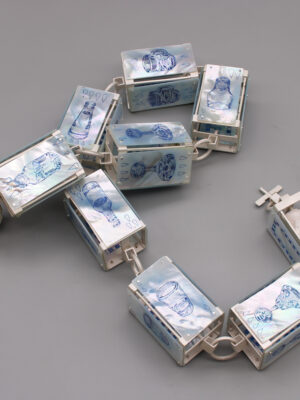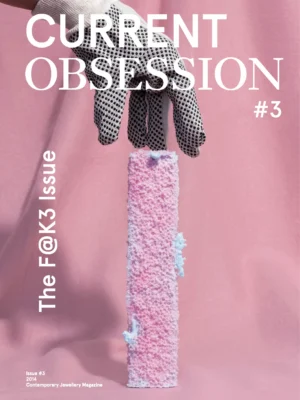We’re supposed to want to be in that world of crystal, with its smooth inviting surfaces and precise moral angles. But if you linger on the image for a while, which I tend to do when riding the tram, you realise there is nowhere to hide in that world. No deep shadows, no pits, no gullies. It’s flawless, perfect, and caught under a constant spotlight. Nothing lives in these scenes except envy.
Looking past the posters, out at a city like Warsaw, and then to our phones, this bygone vainglorious world of faultless facets looks absurd. For many, the air is acrid, and we’re surrounded by machines crushing, drilling, tearing at the earth, with little but horror cast onto our devices. The ideologies that birthed these cut diamonds are the same ones that bisect our land, carving it up into neat, non-porous parcels with no regard for people or nature. The walls on Poland’s borders are growing taller and sharper, with nostalgia playing its own deadly part.
Like with any form of creative output, jewellery reflects the time in which it’s created. For example, the Arts and Crafts movement shunned faceted stones in favour of cabochon (shaped and polished) gems to create a more organic and natural look, eschewing the industrialised, machine-led factory reality of the time. Railing against repetition and regularity, their gentle protest was one of curves and figurative designs.* So, for the totalitarians and populists of today, the ‘Nostalgia’ collections are the only collections for these times; they represent an imagined past. These jewellery collections coerce us to express ourselves in an acceptable, restrained manner.
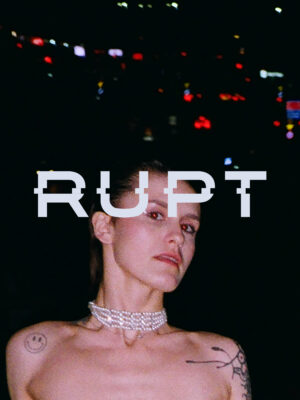
___STEADY_PAYWALL___
But there are others working on different aesthetics, far from the idealised romanticism of the past. Taking cues from dark ecology, folklore, RPG games, and iconoclasm, a group of Polish designers are creating pieces that confront, tarnish, fade, invite, prick, and contest. In Katowice, Kraków, and Warsaw, small studios are diligently crafting a style of jewellery that rejects anachronisms. There is no formal movement yet, no monumental show that has brought them all together. But the tendrils are there, feeling their way through the rubble.
RUPT, a new Wrocław-based online jewellery store, is positioning itself at the centre of Poland’s new wave of designers. While they don’t single out anything particularly idiosyncratic about the scene, they do say that materials are becoming a characteristic defining the contemporary Polish scene. ‘…Amber would definitely be our example, and silver too, since it’s no longer associated with tackiness, and gold is no longer the only “right” material. The materials are also strongly related to geography, e.g., amber is mainly found among designers on the coast. In southern Poland, one can encounter inspiration and influences related to what Silesia** is known for, with references to mining or even jewellery made from coal.’
The artefacts become less about prestige and more about creating a personal mythology of the present as a way to navigate through it. They give the wearer the confidence to live in the now and not in some imagined past.
RUPT suggests that jewellery is becoming more unisex and less conventional, saying that it can be naughty, experimental, controversial, and sharp. Polish designers, they believe, are not afraid to experiment and break standards.
Take the work of Alx.Bjx, for example. At first, his work seems like it’s on the offensive, and essentially, it is. The material fulfils its intended purpose. The metal is sharp, standoffish, and waiting to pounce. The works bring what we usually keep at arm’s length, sharp metal that can pierce, into an intimate relationship with the body. Like the bejewelled daggers of 18th-century England, they’re ornamental with intent. In the case of Alx, some of his work features Catholic iconography adorned with juts of rough, tarnished metal.
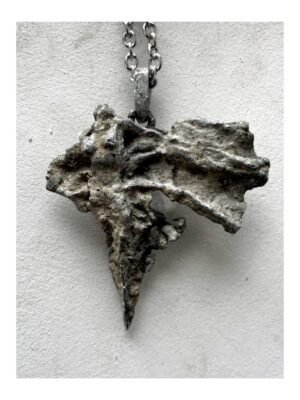
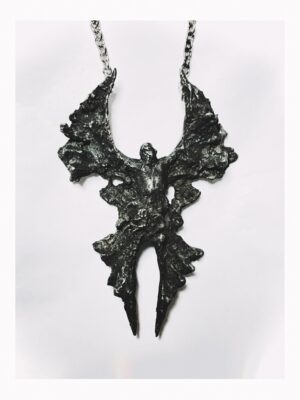
The work of Warsaw-based Fruiting Bodies offers a softer side to the scene, describing their work as ‘an effect of inspiration by living structures and their rebellious spirit. Quiet but stubborn, they settle where they choose to, and there’s no way to control them.’ You can see their designs taking inspiration from nature’s more gloopy, bubbly side. The mossmorphic and lichenphilic designs float on Instagram ads and across their webpage. There is nothing static or timeless about their work in the traditional sense. They feel transitional and convey a sense of movement and growth that’s rare in design. It’s as if the wearer can slip between worlds and roles as easily as a bee in the morning mist.
These designers are providing us with an antithesis to challenge the sentimental world the ‘Nostalgia’ collections invite us to inhabit: f*ck sepia, empty symbolism, exploitative labour practices, and dressing smart in a state of collapse. This is the jewellery of now. It’s corporeal, arboreal. It’s what you wear while living through the sixth mass extinction. It both mourns and celebrates. The organic and mythic shapes demonstrate a forlorn love for the natural world that has maybe come too late.
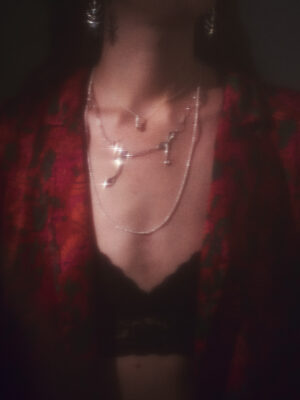
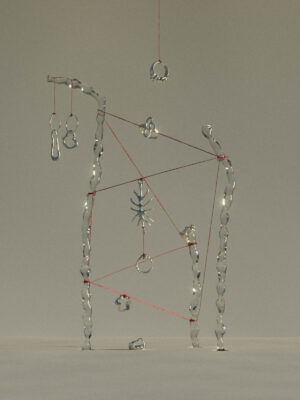
Barbara Serafinowicz, one of the co-founders of RUPT, points out that ‘jewellery has always been closely associated with symbolism and still is. It provides the opportunity to build and express one’s identity, to be a message to the world. It’s a deeply personal item, often carrying an emotional charge linked to experiences.’ So, is it any wonder that work like this is coming from a country rich in folklore, steeped in a history of fundamentalist Catholicism, swamps, ancient forests, rampant urbanisation, and militarised borders?
Another jeweller working in this realm is Artur Rozen, also known as Robien Scrapyard, whose work presents a sense of the natural world, though on closer inspection, some pieces seem as if they’re cast from a ripe pustule. They’re decidedly organic, but closer to its sweet decaying side than to its idealised state. When asked about his work, he says, “Young people, or those who continue to consider themselves young, can’t afford gold and diamonds. Moreover, gold and diamonds are more symbols of status, tradition, and a certain kind of stability than an image of the present. In a world of widening social disparities dictated by the accumulation of capital, few from the younger generation wish to emphasise their adherence to old and traditionally compromised values. As for aesthetics, ‘predatory’ shapes can be dominant. Given we live in a time of great uncertainty, these aesthetics are a manifestation, counteracting anxiety, adding confidence, possibly even encasing oneself in artefacts akin to enhancing a character in an inventory window in an RPG game…my idea is to create something along the lines of a post-modern/living Wunderkammer.”
This is the jewellery of now. It’s corporeal, arboreal. It’s what you wear while living through the sixth mass extinction. It both mourns and celebrates. The organic and mythic shapes demonstrate a forlorn love for the natural world that has maybe come too late.
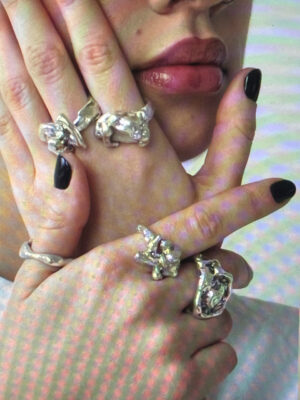

The idea of encasing oneself in artefacts, or likening wearing jewellery to enhancing a character in an inventory window in an RPG game, aptly sums up the direction this jewellery is taking. The artefacts become less about prestige and more about creating a personal mythology of the present as a way to navigate through it. They give the wearer the confidence to live in the now and not in some imagined past.
This sentiment is also echoed by designer Max Gorski, @eyo92, whose designs weave a new folkloric tale, rather than attempting to replicate old ones. Their work “captures a feeling of mystical, magical realism, and translates it into the daily perspective of living in the shadowy atmosphere of dark city corners.” Here are the shadows to lurk in and with. Inspired by horror movies, post-human aesthetics, and every aspect of ugliness that might be transformed into beauty, their work converts symbolism into its own sense of meaning, rather than employing it directly.
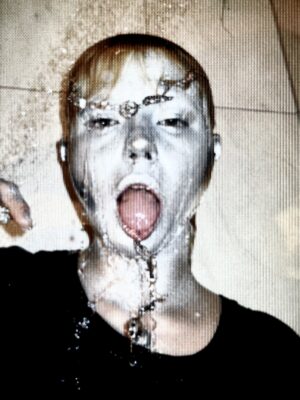
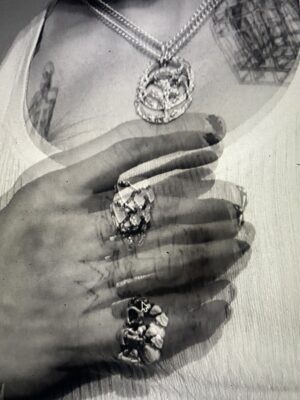
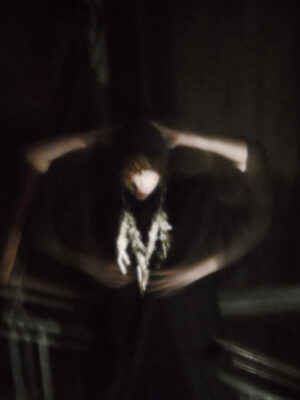
The sense of decay is palpable too, contributing to what Gorski describes as the fairytale-esque feeling of the entire project. The designer shares a similar perspective on materials, critiquing diamonds as unaffordable, uninspiring, and monochromatic, whilst advocating for tarnished metals which allow room for experimentation with shape, contrast, and texture.
As a foreigner living in Poland, I may be prone to romanticising, but while this jewellery ties into international trends, it also feels particularly Polish. In my view, what we’re seeing in this work are totems for a new mythology, to better situate ourselves in an age of ecosystem collapse. However we label them, this jewellery and its designers speak to our shared reality without a filter. When I wear and look at this jewellery, the words of political philosopher Antonio Gramsci often come to mind: ‘The old world is dying, and the new world struggles to be born: now is the time of monsters.’
** Silesia is a historical region of Central Europe that lies mostly within Poland.
This article is part of a larger exploratory series called Urban Mythology commissioned by Current Obsession. The theme blends personal mythology and modernised traditions to present a new take on identity, oral history, and symbolic language. Reclaiming history and decolonising the past and future through innovative narratives and in-depth research, it examines anything from beliefs, (cyber) deities, folklore, shamanism, to the creative prowess of multicultural artists. Diving into a world where ethereality meets living jewellery, where history is not just retold but reimagined. Urban Mythology seeks to explore the richness of our past and present, redefining our traditions and propelling us towards an uncharted future.
Josh Plough is an educator and researcher who focuses on the sordid world of design and its position in the webs of folklore, identity, politics and futures. He received his MA in Design Curating and Writing from the Design Academy Eindhoven and cut his teeth at the independent publishers and exhibition space Onomatopee Projects. Currently based in Warsaw, he established the cultural foundation and library Ziemniaki i, which researches the social relevance of myth and folk practices by placing them in the context of populist politics, belief and digital technologies. Josh was the recipient of the 2022 Fondazione Fitzcarraldo scholarship in Cultural Policies at Conservatorio della Svizzera Italiana and a contributing writer to DAMN Magazine, Reset! Network, Revista-ARTA, Dialog, FORMY, CritiCALL! and The Future of.
Cover image: © Max Gorski. Courtesy of the artist.

